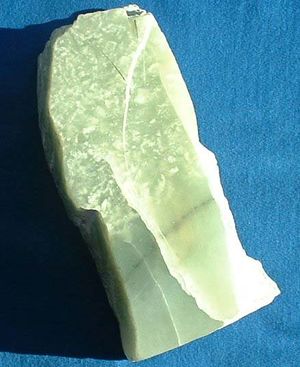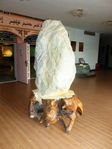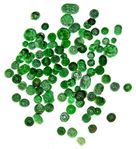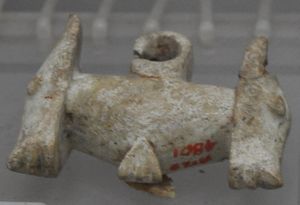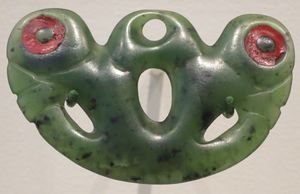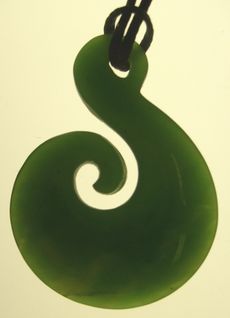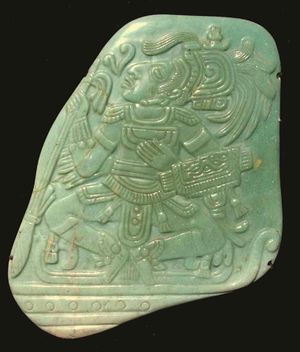يشب
اليشْب أو "الجاد "إنگليزية: Jade هو من الأحجار الكريمة ويتخذ للزينة وجلب الحظ. عادةً يكون لونه أخضر ولكنه يوجد بجميع الألوان ما عدا الأزرق. ويكثر استعماله في الصين حيث تُعتبر الأيقونات والتمائم والحلي المصنوعة منه جالبةً للحظ والسعادة.
يوجد من اليشب نوعان أساسيان مختلفان من حيث التكوين الذري ولكنهما يشتركان في نظام بلوري واحد لتوزيع الذرات، وهما:
- الجادييت وهو الأكثر غلاءً وجمالاً ويتكون من سيليكات الألمنيوم والصوديوم.
- النفريت الذي يتكون من سيليكات الكالسيوم والمغنيزيوم والحديد.
تعتبر ميانمار المنطقة الرئيسة في العالم لاستخراج اليشم من نوع الجادييت، تليها گواتيمالا في أمريكا اللاتينية. أما النوع الثاني، النيفريت، فيوجد في العديد من البلدان كنيوزيلندا والصين وتايوان وكندا والولايات المتحدة وروسيا.
. . . . . . . . . . . . . . . . . . . . . . . . . . . . . . . . . . . . . . . . . . . . . . . . . . . . . . . . . . . . . . . . . . . . . . . . . . . . . . . . . . . . . . . . . . . . . . . . . . . . . . . . . . . . . . . . . . . . . . . . . . . . . . . . . . . . . . . . . . . . . . . . . . . . . . . . . . . . . . . . . . . . . . . .
التاريخ
صناعة اليشب في الصين تعتبر صناعة قديمة وتاريخية ، وشاهد ذلك أن آثارها وجدت في أقدم القبور. وتعزو أقدم السجلات أول استخدامه"حجر سمع"إلى عام 2500 ق.م. وذلك أن حجر اليشب كان يقطع على صورة سمكة أو نحوها تعلق في إسار ؛ فإذا ما أجيد قطع الحجر وتعليقه خرجت منه أنغام موسيقية واضحة جميلة تدوم مدهشاً في طوله. والاسم الإنجليزي لهذا الحجر Jade مشتق من اللفظ الأسباني Ijada (المأخوذة عن اللفظ اللاتيني Ilia) عن طريق اللفظ الفرنسي Jade ومعناه الحقو. ولما فتح الأسبان أمريكا وجد الفاتحون أهل المكسيك الأقدمين يأتون بهذا الحجر مسحوقاً ومعجوناً بالماء ليعالجوا به كثيراً من الأمراض الباطنية ، فلما عادوا إلى أوربا حملوا معهم هذا العلاج هو والذهب الأمريكي إلى بلادهم. أما الاسم الصيني لهذا الحجر فهو أليق به من الاسم الأوربي وأكثر مطابقة للمعقول. فلفظ جون الذي يطلق عليه معناه لين كالندا ، ويتركب حجر اليشب من معدني الجاديث و التفريت ، والأول يتكون من سليكات الألومنيوم والصوديوم ويتكون الثاني من الكالسيوم والمغنيزيوم. وكلا المعدنين صلب قاس يحتاج تهشيم البوصة المكعبة منه إلى ضغط خمسين طنا في بعض الأحيان. وتكسر القطع الكبيرة منه عادة بتعريضها إلى الحرارة الشديدة ثم إلى الماء البارد على التعاقب. وفي وسع الإنسان أن يدرك حذق الفنان الصيني من قدرته على إظهار ألوان براقة خضراء وسمراء وسوداء بيضاء من هذا الحجر العديم اللون بطبيعته ، ومن صبره الطويل ومثابرته ، حتى يخرج منه أشكالا مختلفة لا عداد لها ، حتى لا يكاد الإنسان يجد بين مجموعات اليشب التي في العالم كله قطعتين متماثلتين ، اللهم إلا أزرار الملابس. وكان أول ما عثر عليه من مصنوعات يشبية في عهد أسرة شانج في صورة ضفدعة تستخدم قرباناً مقدساً ، وصنعت منه أدوات غاية في الجمال في أيام كنفوشيوس. وبينما كان الناس في غير الصين يتخذون من اليشب فؤوساً ، ومدى وأواني ، فإن الصينيين كانوا يعظمون الحجر تعظيماً حملهم على ألاّ يستخدموه إلا في التحف الفنية الجميلة ، إذا استثنينا بعض القطع النادرة القليلة العدد.
وكان عندهم أثمن من الفضة و الذهب والحلي على اختلاف أنواعها. وكانوا يقدرون بعض مصنوعات اليشب الصغيرة كخواتم الإبهام التي يتحلى بها كبار الحكام الصينيين بما يقرب من خمسة آلاف ريال ، ويقدرون بعض القلائد اليشيبية بمائة آلاف ريال. وكان المعنيون بجمع القطع النادرة منه يقضون السنين الطوال في البحث عن قطعة واحدة، ويقال إن ما يوجد في الصين من التحف اليشبية إذا جمعت في مكان واحد تكونت منها مجموعة لا تماثلها مجموعة من أية تحف صنعت من مادة أخرى في جميع أنحاء العالم(36). ولا يكاد البرنز يقل قدماً عن اليشب في الفن الصيني ، وهو يفوقه مقاماً وتقديراً عند الصينيين. وتروى الأقاصيص الصينية أن الإمبراطور يو ، أحد أباطرة الصين الأقدمين وبطل الطوفان الصيني ، تلقى المعادن التي بعثت بها إليه الدويلات التسع الخاضعة لحكمه ، وهى الخراج المفروض عليها ، ثم صبها كلها وصنع منها ثلاث قدور لكل منها تسع أرجل، لها من القوة السحرية وتستطيع به أن تدفع المؤثرات البغيضة، وتجعل ما يوضع فيها من المواد يغلى بغير النار ، ويخرج منها كل ما لذ وطاب من طعام وشراب. ثم أصبحت هذه القدور الرمز المقدس للسلطة الإمبراطورية ، وتوارثتها الأسر واحدة بعد واحدة ، فكانت كل منها تتلقاها بعناية فائقة من التي قبلها ، ولكنها اختفت بطريقة مجهولة غامضة بعد سقوط أسرة جو ، وهي حادثة كان لها أسوأ الأثر في منزله شى هوانج دي.
الصين قبل التاريخ والمبكرة

During Neolithic times, the key known sources of nephrite jade in China for utilitarian and ceremonial jade items were the now-depleted deposits in the Ningshao area in the Yangtze River Delta (Liangzhu culture 3400–2250 BC) and in an area of the Liaoning province and Inner Mongolia (Hongshan culture 4700–2200 BC).[1] Dushan Jade was being mined as early as 6000 BC. In the Yin Ruins of the Shang Dynasty (1600 to 1050 BC) in Anyang, Dushan Jade ornaments were unearthed in the tomb of the Shang kings.
Jade was used to create many utilitarian and ceremonial objects, from indoor decorative items to jade burial suits. Jade was considered the "imperial gem". From the earliest Chinese dynasties to the present, the jade deposits most in use were not only those of Khotan in the Western Chinese province of Xinjiang but other parts of China as well, such as Lantian, Shaanxi. There, white and greenish nephrite jade is found in small quarries and as pebbles and boulders in the rivers flowing from the Kuen-Lun mountain range eastward into the Takla-Makan desert area. The river jade collection is concentrated in the Yarkand, the White Jade (Yurungkash) and Black Jade (Karakash) Rivers. From the Kingdom of Khotan, on the southern leg of the Silk Road, yearly tribute payments consisting of the most precious white jade were made to the Chinese Imperial court and there worked into objects d'art by skilled artisans as jade had a status-value exceeding that of gold or silver. Jade became a favourite material for the crafting of Chinese scholars' objects, such as rests for calligraphy brushes, as well as the mouthpieces of some opium pipes, due to the belief that breathing through jade would bestow longevity upon smokers who used such a pipe.[2]
Jadeite, with its bright emerald-green, pink, lavender, orange and brown colours was imported from Burma to China only after about 1800. The vivid green variety became known as Feicui (翡翠) or Kingfisher (feathers) Jade. It quickly became almost as popular as nephrite and a favorite of Qing Dynasty's nouveau riche, while scholars still had strong attachment to nephrite (white jade, or Khotan), which they deemed to be the symbol of a nobleman.
In the history of the art of the Chinese empire, jade has had a special significance, comparable with that of gold and diamonds in the West.[3] Jade was used for the finest objects and cult figures, and for grave furnishings for high-ranking members of the imperial family.[3] Due to that significance and the rising middle class in China, in 2010 the finest jade when found in nuggets of "mutton fat" jade – so-named for its marbled white consistency – could sell for $3,000 an ounce, a tenfold increase from a decade previously.[4]
The Chinese character 玉[5] (yù) is used to denote the several types of stone known in English as "jade" (e.g. 玉器, jadewares), such as jadeite (硬玉, 'hard jade', another name for 翡翠) and nephrite (軟玉, 'soft jade'). But because of the value added culturally to jades throughout Chinese history, the word has also come to refer more generally to precious or ornamental stones,[6] and is very common in more symbolic usage as in phrases like 拋磚引玉/抛砖引玉 (lit. 'casting a brick (i.e. the speaker's own words) to draw a jade (i.e. pearls of wisdom from the other party)'), 玉容 (a beautiful face; 'jade countenance'), and 玉立 (slim and graceful; 'jade standing upright'). The character has a similar range of meanings when appearing as a radical as parts of other characters.
Head and torso fragment of a jade statuette of a horse, Chinese Eastern Han period (25–220 AD)
Large "mutton fat" nephrite jade displayed in Hotan Cultural Museum lobby.
A selection of antique, hand-crafted Chinese jade buttons
الهند قبل التاريخ والمبكرة
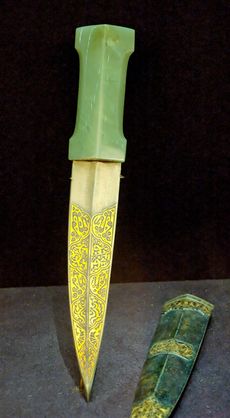
The Jain temple of Kolanpak in the Nalgonda district, Andhra Pradesh, India is home to a 5-foot (1.5 m) high sculpture of Mahavira that is carved entirely out of jade. It is the largest sculpture made from a single jade rock in the world. India is also noted for its craftsman tradition of using large amounts of green serpentine or false jade obtained primarily from Afghanistan in order to fashion jewellery and ornamental items such as sword hilts and dagger handles.[7]
كوريا قبل التاريخ والمبكرة
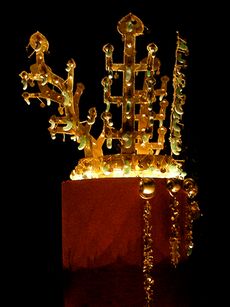
The use of jade and other greenstone was a long-term tradition in Korea (c. 850 BC – AD 668). Jade is found in small numbers of pit-houses and burials. The craft production of small comma-shaped and tubular "jades" using materials such as jade, microcline, jasper, etc., in southern Korea originates from the Middle Mumun Pottery Period (c. 850–550 BC).[8] Comma-shaped jades are found on some of the gold crowns of Silla royalty (c. 300/400–668 AD) and sumptuous elite burials of the Korean Three Kingdoms. After the state of Silla united the Korean Peninsula in 668, the widespread popularisation of death rituals related to Buddhism resulted in the decline of the use of jade in burials as prestige mortuary goods.
جنوب شرق آسيا
Today, it is estimated that Myanmar is the origin of upwards of 70% of the world's supply of high-quality jadeite. Most of the jadeite mined in Myanmar is not cut for use in Myanmar, instead being transported to other nations, primarily in Asia, for use in jewelry and other products. The jadeite deposits found in Kachinland, in Myanmar's northern regions is the highest quality jadeite in the world, considered precious by sources in China going as far back as the 10th century.
Jadeite in Myanmar is primarily found in the "Jade Tract" located in Lonkin Township in Kachin State in northern Myanmar which encompasses the alluvial region of the Uyu River between the 25th and 26th parallels. Present-day extraction of jade in this region occurs at the Phakant-gyi, Maw Se Za, Tin Tin, and Khansee mines. Khansee is also the only mine that produces Maw Sit Sit, a type of jade. Mines at Tawmao and Hweka are mostly exhausted. From to 1964 to 1981, mining was exclusively an enterprise of the Myanmar government. In 1981, 1985, and 1995, the Gemstone laws were modified to allow increasing private enterprise. In addition to this region, there are also notable mines in the neighboring Sagaing District, near the towns of Nasibon and Natmaw and Hkamti. Sagaing is a district in Myanmar proper, not a part of the ethic Kachin State.
Archaeologists have discovered two forms of jade that can be found across Taiwan through the Philippines, East Malaysia, central and southern Vietnam, and even extending to eastern Cambodia and peninsular Thailand. These two forms are called lingling-o penannular earring with three pointed circumferential projections and the double animal-headed ear pendant. The forms are very similar in size and range from about 30–35 mm in diameter. Furthermore, radiocarbon dates have dated these forms in Southeast Asia from around 500 BC to 500 AD.[9] Electron probe microanalysis shows that the raw material of these two types of artifacts was nephrite jade from Taiwan called Fengtian nephrite. Evidence recovered from multiple sites from Taiwan, the Philippines, and the mainland southeast Asia suggests that Taiwan was the main source of the exchange of this kind of jade. During the Iron Age of Southeast Asia, there may have been skilled craftsmen traveling from Taiwan to southeast Asia along the coastline of the South China Sea, making jade ornaments for local inhabitants.[9]
ماوري
Nephrite jade in New Zealand is known as pounamu in the Māori language (often called "greenstone" in New Zealand English), and plays an important role in Māori culture. It is considered a taonga, or treasure, and therefore protected under the Treaty of Waitangi, and the exploitation of it is restricted and closely monitored. It is found only in the South Island of New Zealand, known as Te Wai Pounamu in Māori—"The [land of] Greenstone Water", or Te Wahi Pounamu—"The Place of Greenstone".
Pounamu taonga increase in mana (prestige) as they pass from one generation to another. The most prized taonga are those with known histories going back many generations. These are believed to have their own mana and were often given as gifts to seal important agreements.
Tools, weapons and ornaments were made of it; in particular adzes, the 'mere' (short club), and the hei-tiki (neck pendant). Nephrite jewellery of Maori design is widely popular with locals and tourists, although some of the jade used for these is now imported from British Columbia and elsewhere.[10]
Pounamu taonga include tools such as toki (adzes), whao (chisels), whao whakakōka (gouges), ripi pounamu (knives), scrapers, awls, hammer stones, and drill points. Hunting tools include matau (fishing hooks) and lures, spear points, and kākā poria (leg rings for fastening captive birds); weapons such as mere (short handled clubs); and ornaments such as pendants (hei-tiki, hei matau and pekapeka), ear pendants (kuru and kapeu), and cloak pins.[11][12] Functional pounamu tools were widely worn for both practical and ornamental reasons, and continued to be worn as purely ornamental pendants (hei kakï) even after they were no longer used as tools.[13]
. . . . . . . . . . . . . . . . . . . . . . . . . . . . . . . . . . . . . . . . . . . . . . . . . . . . . . . . . . . . . . . . . . . . . . . . . . . . . . . . . . . . . . . . . . . . . . . . . . . . . . . . . . . . . . . . . . . . . . . . . . . . . . . . . . . . . . . . . . . . . . . . . . . . . . . . . . . . . . . . . . . . . . . .
وسط أمريكا
Jade was a rare and valued material in pre-Columbian Mesoamerica. The only source from which the various indigenous cultures, such as the Olmec and Maya, could obtain jade was located in the Motagua River valley in Guatemala.[بحاجة لمصدر] Jade was largely an elite good, and was usually carved in various ways, whether serving as a medium upon which hieroglyphs were inscribed, or shaped into symbolic figurines. Generally, the material was highly symbolic, and it was often employed in the performance of ideological practices and rituals.
كندا
Jade was first identified in Canada by Chinese settlers in 1886 in British Columbia[بحاجة لمصدر]. At this time jade was considered worthless because they were searching for gold[بحاجة لمصدر]. Jade was not commercialized in Canada until the 1970s. The mining business Loex James Ltd., which was started by two Californians, began commercial mining of Canadian jade in 1972.[14]
Mining is done from large boulders that contain bountiful deposits of jade. Jade is exposed using diamond-tipped core drills in order to extract samples. This is done to ensure that the jade meets requirements. Hydraulic spreaders are then inserted into cleavage points in the rock so that the jade can be broken away. Once the boulders are removed and the jade is accessible, it is broken down into more manageable 10-tonne pieces using water-cooled diamond saws. The jade is then loaded onto trucks and transported to the proper storage facilities.[15]
المعدن
Nephrite and jadeite
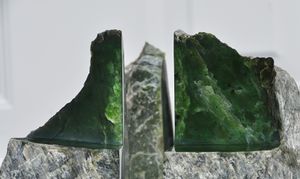
It was not until 1863 that French mineralogist Alexis Damour determined that what was referred to as "jade" could in fact be one of two different minerals, either nephrite or jadeite.[16]
تنويعات غير معتادة
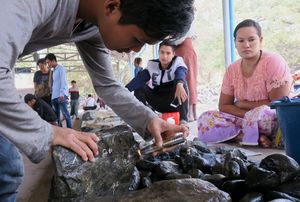
انظر أيضاً
- Cheonmachong – Tumulus of the Silla kingdom in Korea, containing jade artifacts
- Costa Rican jade tradition
- Jade burial suit
- Jade trade in Myanmar
- Mumun pottery period – Time in Korea when jade ornament production began
- Nephrite
- Philippine jade artifacts
- Pounamu – Type of hard stone found in New Zealand, some of which are nephrite
- Serpentine subgroup – Group of minerals, some of which are known as false jade
- Name of 35th wedding anniversary
المراجع
- ^ Liu, Li 2003:3–15
- ^ Martin, Steven. The Art of Opium Antiques. Silkworm Books, Chiang Mai, 2007
- ^ أ ب Jade. Gemstone.org
- ^ Jacobs, Andrew (September 20, 2010). "Jade From China's West Surpasses Gold in Value". The New York Times. New York: NYTC. ISSN 0362-4331. Retrieved October 13, 2012.
- ^ zh:玉
- ^ Gem News, Gems & Gemology[صفحة مطلوبة]
- ^ خطأ استشهاد: وسم
<ref>غير صحيح؛ لا نص تم توفيره للمراجع المسماةHunter - ^ Bale, Martin T. and Ko, Min-jung. Craft Production and Social Change in Mumun Pottery Period Korea. Asian Perspectives 45(2):159–187, 2006.
- ^ أ ب Hung, H. C.; Iizuka, Y.; Bellwood, P.; Nguyen, K. D.; Bellina, B.; Silapanth, P.; and Manton, J. H. (2007). "Ancient jades map 3,000 years of prehistoric exchange in Southeast Asia". Proceedings of the National Academy of Sciences, 104(50), 19745–19750.
- ^ Salt, Donn, 1992, Stone, Bone and Jade – 24 New Zealand Artists, David Bateman Ltd., Auckland.
- ^ "Pounamu taonga". Collections Online. Museum of New Zealand Te Papa Tongarewa. Retrieved 25 November 2010.
{{cite web}}: Cite has empty unknown parameter:|coauthors=(help) - ^ Keane, Basil (2 March 2009). "Pounamu – jade or greenstone – Implements and adornment". Te Ara – the Encyclopedia of New Zealand. Ministry for Culture & Heritage. Retrieved 21 November 2010.
{{cite web}}: Cite has empty unknown parameter:|coauthors=(help) - ^ "Collections Online – Museum of New Zealand Te Papa Tongarewa". collections.tepapa.govt.nz. Retrieved 26 January 2019.
- ^ Talbot, Matthew. "In Depth Green With Jade". Canadian Geographic. Archived from the original on 6 November 2014. Retrieved 6 November 2014.
{{cite web}}: Unknown parameter|deadurl=ignored (|url-status=suggested) (help) - ^ "What is Jade?". Polar Jade. Retrieved 6 November 2014.
- ^ "Jade, greenstone, or pounamu?". Retrieved 9 October 2018.
للاستزادة
- Rémusat, Abel, 1820. Histoire de la ville de Khotan: tirée des annales de la chine et traduite du chinois ; Suivie de Recherches sur la substance minérale appelée par les Chinois PIERRE DE IU, et sur le Jaspe des anciens. Abel Rémusat. Paris. L’imprimerie de doublet. 1820. Downloadable from: [1]
- Laufer, Berthold, 1912, Jade: A Study in Chinese Archeology & Religion, Reprint: Dover Publications, New York. 1974.
- Rawson, Jessica, 1975, Chinese Jade Throughout the Ages, London: Albert Saifer, ISBN 0-87556-754-1
- Ward, Fred (September 1987). "Jade: Stone of Heaven". National Geographic. Vol. 172, no. 3. pp. 282–315. ISSN 0027-9358. OCLC 643483454.
- Jadeite sources in Mesoamerica (PDF)
- Between hell and the Stone of Heaven: Observer article on Jade Mining in Burma
- Old Chinese Jades: Real or Fake?
- Types of jade: 100 stone images with accompanying information
وصلات خارجية
- Gemstone at the Open Directory Project
- The British Museum – 7,000 years of Chinese jade
- Gravity Measurement For Testing Jade (2008 archived version)
- mindat.org (Mineralogical data about Jade)
- Jade in Canada
- "Jade in British Columbia table", BC Govt MINFILE summary of jade showings and producers
- Canadian Rockhound magazine feature on jade
. . . . . . . . . . . . . . . . . . . . . . . . . . . . . . . . . . . . . . . . . . . . . . . . . . . . . . . . . . . . . . . . . . . . . . . . . . . . . . . . . . . . . . . . . . . . . . . . . . . . . . . . . . . . . . . . . . . . . . . . . . . . . . . . . . . . . . . . . . . . . . . . . . . . . . . . . . . . . . . . . . . . . . . .
المصادر
- http://ar.wikipedia.org
- ديورانت, ول; ديورانت, أرييل. قصة الحضارة. ترجمة بقيادة زكي نجيب محمود.
- مقالات بالمعرفة بحاجة لذكر رقم الصفحة بالمصدر from October 2016
- CS1 errors: unsupported parameter
- Articles containing إنگليزية-language text
- Articles with hatnote templates targeting a nonexistent page
- Articles with unsourced statements from August 2018
- Articles with unsourced statements from August 2019
- معادن
- أحجار كريمة

